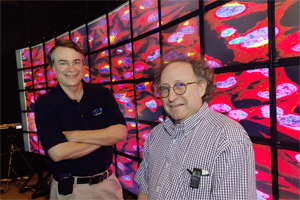Leading Scientists Help Guide New Nationwide Networking Infrastructure
February 1, 2006 / By Doug Ramsey
|
Cypress and San Diego, CA, February 1, 2006 -- Two of the eight scientists appointed to a new Science Research Council for National LambdaRail (NLR) are affiliated with Calit2: director Larry Smarr, and UCSD neuroscientist Mark Ellisman.
NLR is a consortium of leading U.S. research universities and private sector technology companies that is deploying a nationwide optical, Ethernet and IP networking infrastructure. It has gathered a team of leading scientists to ensure NLR resources are available and responsive to a broad range of researchers. The NLR Science Research Council (NSRC) is chaired by David J. Farber, NLR's Chief Scientist and a distinguished professor at Carnegie Mellon University.
NLR provides researchers unprecedented control over a nationwide network infrastructure with up to 40 individual lightpaths--each of which can transmit data at 10 gigabits per second and be used to deploy dedicated side-by-side, but physically and operationally separate, production and experimental networks. NLR is committed to promoting the extensive and active use of its infrastructure and resources by diverse groups within the scientific research community.
"National LambdaRail makes available to scientific researchers a unique set of resources that can respond to their most demanding networking requirements," said David Farber, NLR Chief Scientist and chair of the NLR Science Research Council. "Increasingly, leading- edge research projects require the kind networking capabilities NLR has deployed."
In addition to providing NLR with guidance about principles and policies for the use of the NLR infrastructure in support of scientific research, the NSRC will provide NLR leadership with guidance about opportunities and strategies to ensure the NLR backbone and related resources remain responsive to evolving demands of the science and research environment.
"Some of today's most ambitious scientific research projects rely on the most advanced networking capabilities, such as those available on through NLR," said Larry Smarr, founding director of the California Institute for Telecommunications and Information Technology and Harry E. Gruber professor in the Jacobs School's Department of Computer Science and Engineering at UCSD. "Providing active scientists an integral role in NLR will help ensure it remains responsive to the needs of researchers across a wide range of scientific disciplines."
In addition to David Farber and Calit2's Smarr and Ellisman, members of the NNRC include:
- Charlie Catlett, Argonne National Laboratory
- James Cordes, Cornell University
- Kelvin Drogemeier, University of Oklahoma
- Harvey Newman, California Institute of Technology
- Ed Seidel, Louisiana State University
The NLR infrastructure is already supporting cutting-edge uses of optical networking capabilities in research and education, including the National Science Foundation-supported Extensible Terascale Facility and OptIPuter projects, the U.S. Department of Energy's UltraScience project, CENIC and the Pacific Northwest Gigapop’s Pacific Wave project, and Internet2's Hybrid Optical Packet Infrastructure (HOPI) project.
About National LambdaRail
National LambdaRail, Inc. (NLR) is a major initiative of U.S. research universities and private sector technology companies to provide a national scale infrastructure for research and experimentation in networking technologies and applications. NLR puts the control, the power and the promise of experimental network infrastructure in the hands of our nation's scientists and researchers.
Related Links
Media Contacts
Media Contact: Greg Wood, National LambdaRail, ghwood@nlr.net, 703-625-3917
Doug Ramsey, Calit2, dramsey@ucsd.edu, 858-822-5825


